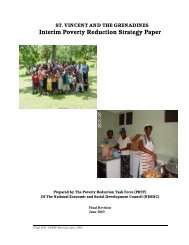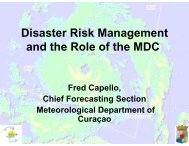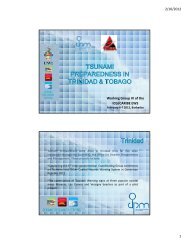The Anatomy of A Silent Crisis The Anatomy of A Silent Crisis
The Anatomy of A Silent Crisis The Anatomy of A Silent Crisis
The Anatomy of A Silent Crisis The Anatomy of A Silent Crisis
- TAGS
- anatomy
- www.bb.undp.org
You also want an ePaper? Increase the reach of your titles
YUMPU automatically turns print PDFs into web optimized ePapers that Google loves.
40 Forum 2009: Climate Change – <strong>The</strong> <strong>Anatomy</strong> <strong>of</strong> a <strong>Silent</strong> <strong>Crisis</strong><br />
“ Humanity will face major water challenges in the next<br />
few decades in certain regions <strong>of</strong> the world related to<br />
the impacts <strong>of</strong> climate change and rapidly growing<br />
human demands for water. However, the picture<br />
may be less bleak than widely portrayed — if overall<br />
water resources are managed better, future food<br />
crises could be significantly reduced.”<br />
Johan Rockström — Executive Director, Stockholm Environment Institute (SEI) and<br />
Stockholm Resilience Centre<br />
Water: Climate change exacerbates already shrinking fresh water availability<br />
Freshwater supply and quality are strongly affected by climate change<br />
As the climate warms, it changes the nature <strong>of</strong> global rainfall, evaporation, snow, stream flow<br />
and other factors that affect water supply and quality. 116 Freshwater resources are highly sensitive<br />
to variations in weather and climate. Climate change is projected to affect water availability.<br />
Growing evidence suggests that it speeds up the water cycle, which can bring longer droughts<br />
and more intense periods <strong>of</strong> rain. 117,118 This makes wet regions even wetter and arid areas drier. 118<br />
In areas where the amount <strong>of</strong> water in rivers and streams depends on snow melting, warmer<br />
temperatures increase the fraction <strong>of</strong> precipitation falling as rain rather than as snow, causing the<br />
annual spring peak in water run<strong>of</strong>f to occur earlier in the year. 116 This can lead to an increased<br />
likelihood <strong>of</strong> winter flooding and reduced late summer river flows. 117 Rising sea levels cause<br />
saltwater to enter into fresh underground water and freshwater streams. This reduces the amount<br />
the amount <strong>of</strong> freshwater available for drinking and farming. Warmer water temperatures also affect<br />
water quality and accelerate water pollution. 116<br />
Climate change makes water scarce and unfit for human consumption today and exacerbates<br />
unsustainable water use by farming sector in many water scarce regions<br />
Over 1.3 billion people worldwide are “water stressed,” 119 meaning they are facing extreme water<br />
scarcity. 120 Chronic shortages <strong>of</strong> freshwater are likely to threaten food production, reduce sanitation,<br />
hinder economic development and damage ecosystems. 121 Because <strong>of</strong> this, water scarcity and<br />
reduced quality pose problems that threaten the very survival <strong>of</strong> those affected. For example,<br />
changes in water quantity and quality directly affect food availability. Too little water decreases food







